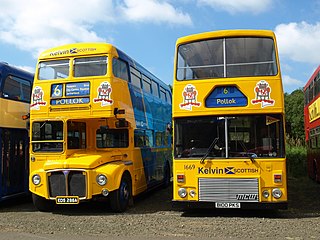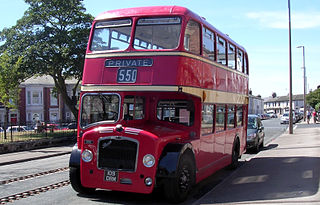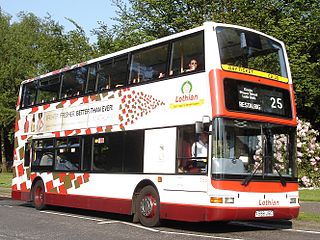Related Research Articles

The history of public transport authorities in London details the various organisations that have been responsible for the public transport network in and around London, England - including buses, coaches, trams, trolleybuses, Docklands Light Railway, and the London Underground.

The AEC Routemaster is a front-engined double-decker bus that was designed by London Transport and built by the Associated Equipment Company (AEC) and Park Royal Vehicles. The first prototype was completed in September 1954 and the last one was delivered in 1968. The layout of the vehicle was conventional for the time, with a half-cab, front-mounted engine and open rear platform, although the coach version was fitted with rear platform doors. Forward entrance vehicles with platform doors were also produced as was a unique front-entrance prototype with the engine mounted transversely at the rear.

Unitrans is the transit system which operates in and around the campus of the University of California, Davis. It takes its name from an abbreviation of the words "University Transport". Excepting several managerial and maintenance positions, Unitrans is managed and operated entirely by students of the University of California, Davis who usually work part-time while attending school. The system is well known throughout the area for its use of several distinctive ex-Transport for London double-decker buses, as well as its fleet of modern natural gas single-decks. The system has 18 weekday, 1 school-centered and 6 weekend routes. Current fares are $1.25 for the general public and included in student fees for undergraduate University attendees. Unitrans is one of a small number of transit systems in the United States to operate double deck buses in regular (non-sightseeing) service. Unitrans has one of the best safety records of any public transit system in the US.

The history of bus transport in Hong Kong began with the introduction of the first bus routes in Hong Kong in the 1920s.

Buses have been used as a mode of public transport in London since 1829, when George Shillibeer started operating a horse-drawn omnibus service from Paddington to the City of London. In the decades since their introduction, the red London bus has become a symbol of the city.

A double-decker bus or double-deck bus is a bus that has two storeys or decks. They are used for mass transport in the United Kingdom, the United States, Canada, New Zealand, Europe, Asia and also in cities such as Sydney; the best-known example is the red London bus, namely the AEC Routemaster.

Kelvin Scottish Omnibuses Ltd was a bus operating subsidiary of the Scottish Transport Group based in Bishopbriggs, Strathclyde, Scotland. It was formed in March 1985 from parts of Walter Alexander & Sons (Midland) Ltd and Central SMT, initially with six depots and a varied fleet of 381 vehicles.

A bus conductor is a person responsible for collecting fares from bus passengers. Bus conductors were a common feature of many bus services across Europe until the late 1970s and early 1980s. The main reason two-person crews were needed was that most towns and cities used double-decker buses for urban services. Until the 1960s, all double deck vehicles were built with front-mounted engines and a "half-cab" design, such as the AEC Routemaster bus built for London Transport. This layout totally separated the driver from the passenger saloons. The conductor communicated with the driver using a series of bell codes, such as two bells to start.

The Bristol Lodekka was a half-cab low-height step-free double-decker bus built by Bristol Commercial Vehicles in England. It was the first production bus design to have no step up from the passenger entrance throughout the lower deck; although Gilford and Leyland Motors had developed low floor city buses in the 1930s, these did not enter production.

The East Kent Road Car Company Ltd is a bus company formed in 1916 and based in Canterbury, Kent. The company operated bus and coach services in Kent. In 1993 it was one of the first companies to be acquired by the Stagecoach Group, which eventually rebranded the operation as Stagecoach in East Kent, and made it part of the Stagecoach South East bus division.

London Buses route 507 was a Transport for London contracted bus route in London, England. It ran between Waterloo station and Victoria station, and was operated by London General.

London Buses route 207 is a Transport for London contracted bus route in London, England. Running between Hayes bypass and White City bus station, it is operated by Abellio London.

The Daimler Fleetline is a rear-engined double-decker bus chassis which was built between 1960 and 1983.

Articulated buses, popularly called "bendy buses," were introduced to London in October 2001 when two Wright Eclipse Fusion bodied Volvo B7LAs were hired from First Hampshire & Dorset, one of which was repainted into First London's red livery, and six Wright Fusion bodied Volvo B10LAs from First Glasgow for a trial on route 207 between Shepherd's Bush and Hayes-By-Pass.

Red Arrow was a brand name given to several former London bus limited stop routes used as high frequency commuter services in central London. The last Red Arrow services to operate were routes 507 and 521, with the brand being retired altogether in September 2009, only being briefly revived in May 2016 to commemorate its 50th anniversary. On 29 April 2023, routes 507 and 521 were both withdrawn.

The AEC Swift was a rear-engined step entrance single-decker bus chassis manufactured by AEC between 1964 and 1980. The chassis design was closely related to the Leyland Panther. It was available in 33-foot (10 m) and 36-foot (11 m) lengths, with an AEC AH505 or AH691 engine.

Lothian Buses is the largest provider of bus services in and around Edinburgh, the capital city of Scotland. It is entirely municipally owned, being 91% owned by the City of Edinburgh Council, with the remainder owned by Midlothian, East Lothian and West Lothian councils, although it no longer provides bus services in West Lothian under the same name. Lothian Buses plc is registered in Annandale Street, Edinburgh as company number SC096849.

Buses in Ipswich operate in the town of Ipswich in the English county of Suffolk. As of 2013 services are primarily operated by Ipswich Buses and First Norfolk & Suffolk, although other smaller operators, such as Galloway European, Carters Coaches and Beestons, operate routes from the town into the surrounding rural area. Many of the current routes are based on those established at the end of the 19th century when a horse tram network developed.

Southampton Corporation Transport motor bus services started in 1919 as a successor to Southampton Corporation Tramways. After Southampton achieved city status in 1964 it was renamed Southampton City Transport. In 1986, as a result of deregulation it became Southampton Citybus, an arms-length company that was sold to the staff in 1993. It continued trading as Southampton Citybus until it was bought by First Bus in 1997.

Coventry Corporation Transport was the operator of trams and motorbuses in Coventry, Warwickshire from 1912 to 1974. The operations of Coventry Corporation Transport passed to West Midlands Passenger Transport Executive in the local government reorganisation of 1974.
References
- A Report on London's bus services and London Transport's plans for reshaping them. London: London Transport Board. 1966.
- Arnold, Barry; Harris, Mike (1982). Reshaping London's Buses. Harrow Weald: Capital Transport. ISBN 0-904711-34-X.
- Curtis, Colin (1977). Buses of London. London: London Transport. ISBN 0-85329-084-9.
- Garbutt, Paul E (1985). London Transport and the Politicians. Shepperton: Ian Allan. ISBN 0-7110-1478-7.
- Green, Oliver; Reed, John (1983). The London Transport Jubilee Book 1933-1983. London: The Daily Telegraph. ISBN 0-901684-86-4.
- Hibbs, John (1989). The History of British Bus Services (2nd edition). Newton Abbot: David & Charles. ISBN 0-7153-8962-9.
- Russell, Ken (1980). The London Merlin. Harrow Weald: Capital Transport. ISBN 0-904711-23-4.
- 1 2 "Big changes in London bus services coming. One-man operation and shorter routes". The Times . 15 September 1966. p. 11.
- 1 2 3 4 5 6 7 Arnold and Harris (1982), pp.16-23
- ↑ Arnold and Harris (1982), p.88
- 1 2 Ian Smith (1 December 2000). "The London Transport Merlins". Ian's Bus Stop. Retrieved 10 April 2010.
- 1 2 3 4 5 6 7 8 9 10 11 12 13 14 Arnold and Harris (1982), pp.8-15
- 1 2 "Cost Of London Transport. Inquiry To Devise Economies". The Times . 29 April 1953. p. 6.
- 1 2 "Cost Of London Transport Road Improvements First Need, Staggered Hours Urged". The Times . 25 February 1955. p. 4.
- ↑ "London Transport Inquiry Report". Parliamentary Debates (Hansard) . 2 February 1955. Retrieved 10 April 2010.
- ↑ "London Transport Committee's Report". Parliamentary Debates (Hansard) . 29 February 1956. Retrieved 10 April 2010.
- ↑ "Inquiry To Review London Busmen's Pay Meeting Tomorrow To Consider Appeal To End Overtime Ban". The Times . 21 November 1963. p. 14.
- ↑ "Any More Fares?". The Times . 17 December 1963. p. 9.
- ↑ "Bus Fare Rise "Price For Adequate Service" Better Pay, Hours, Holidays Proposed In Report". The Times . 16 April 1964. p. 11.
- ↑ Russell (1980) pp.5-6
- ↑ Curtis (1977), pp.145-148
- ↑ AEC had originally intended to use the "Merlin" name for a heavy duty version of the Swift chassis for export customers only, but none were ever manufactured. Russell (1980), pp.7-8
- 1 2 3 4 Curtis (1977), pp.153-155
- ↑ "Bus tickets at a discount". The Times . 15 September 1966. p. 11.
- ↑ London Transport Board (1966), pp.7-9
- ↑ Arnold and Harris (1982), p.128
- 1 2 3 4 5 Arnold and Harris (1982), pp.24-41
- ↑ "Government Plan For National Transport. Integration of road and rail freight". The Times . 28 July 1966. p. 11.
- ↑ "Transport Bill could benefit bus makers". The Times . 7 December 1967. p. 20.
- ↑ Hibbs (1989) p.286
- ↑ Russell (1980) p.21
- 1 2 3 4 5 6 7 8 9 10 11 12 13 Arnold and Harris (1982), pp.42-57
- ↑ Russell (1980) p.25
- 1 2 3 Hibbs (1989) pp.253-254
- ↑ Russell (1980) p.34-35
- 1 2 Russell (1980) pp.33-35
- 1 2 Arnold and Harris (1982), pp.58-71
- 1 2 Arnold and Harris (1982), pp.88-105
- 1 2 Russell (1980) pp.46-47
- ↑ Russell (1980) p.66
- ↑ Arnold and Harris (1982), pp.109-111